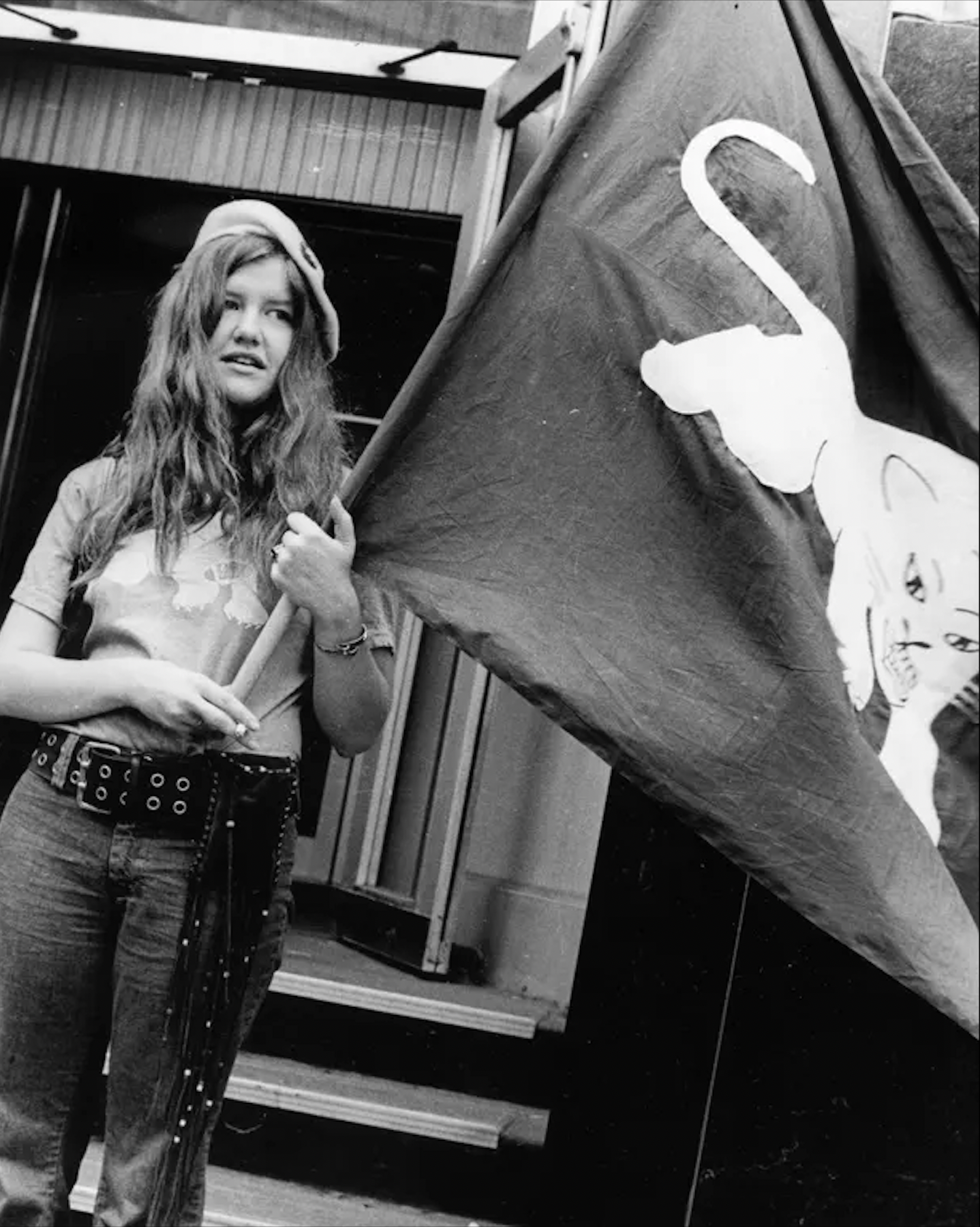By Lynn Burnett
In 1968, Huey Newton was asked during a radio interview what White people could do to support the Black Panther Party: he said that they should form their own organizations in solidarity with the BPP. A White counterculture group who ran the Detroit Artists Workshop, which had a network of communal houses, a print shop, and a performance space heard the interview, and founded the White Panther Party in response to Huey’s suggestion. (It should be said, however, that they chose the name without consulting with the Black Panther Party – the Panthers joked about them being “psychedelic clowns,” until the White Panther Party did a good job distributing the Black Panther Party paper in Detroit).
The White Panther Party had three primary founders: jazz and rock n’ roll photographer Leni Sinclair – who also ran Magic Veil Light Company that produced psychedelic light shows; jazz poet John Sinclair – who managed the gritty proto-punk band MC5; and communal member Pun Plamondon who later drove equipment trucks for rock bands. In the years leading up to the formation of the White Panther Party, the Detroit Artists Workshop was targeted by police and raided numerous times, with 54 people once arrested in a single raid, typically for marijuana possession. Following one police raid, the Detroit Artists Workshop was re-organized into a group called Trans-Love Energies Unlimited, which provided assistance to people who were left homeless after the Detroit uprisings against police brutality in 1967, in which 2000 buildings burned to the ground. During the uprising they flew a banner outside their commune reading “Burn, Baby, Burn!”… leading to further police raids.
White members of the Detroit Artists Workshop were not only receptive to the Panther’s message because of their negative experience with police and their shared vision of capitalism as oppressive: as jazz aficionado John Sinclair puts it, “we dug black people cos that’s where the great music came from and the great weed and the refreshing concepts of sexuality. All that stuff didn’t come from no white people. Are you kidding me?” For the White counterculture figures who joined the White Panther Party, their fantasy of Black culture offered an expression of freedom from everything they felt was wrong with White America.
The White Panthers issued their own ten-point platform. Although it overlaps with the platform of the Black Panther Party, it also expresses the radical countercultural and communal visions of the 1960s. For example, the points include “free time and space for all humans—dissolve all unnatural boundaries!”, and “a free world economy based on the free exchange of energy and materials and the end of money.” The White Panther Party was a group that pledged to support the Black Panther Party and advocated for the freedom of political prisoners and the abolition of systemic racial injustice… alongside free love, rock n’ roll, and the expansion of consciousness through psychedelics. Their belief that basic survival needs should be free led them to pool communal money to purchase bulk foods for redistribution, with the San Francisco chapter feeding 5,000 families at one point.
White Panther Party member Pun Plamondon became the first hippie placed on the FBI’s ten most wanted list: indicted for bombing a local CIA office in 1968, Pun fled to Algeria – where he joined Black Panther Eldridge Cleaver – but returned in 1970 and was soon arrested. Meanwhile, in 1969 John Sinclair was arrested and faced up to ten years in prison for offering two joints to an undercover officer. The harsh sentence mobilized the counterculture: everyone from John Lennon to Stevie Wonder; from Allen Ginsburg to Black Panther Party co-founder Bobby Seale came together for a “John Sinclair Freedom Rally.” Both Sinclair and Plamondon were freed shortly afterwards when it was discovered that the government had been surveiling them without a warrant, in what became a major Supreme Court precedent.
The name “White Panther Party” didn’t sit well with many people, and some even assumed it was a White supremacist group when they first heard about it. Because of this, the group later changed their name to “Trans-Love Energies.”
Additional Resources
Primary Source
White Panther Party 10-Point Program.
Books
John Curl: For All the People: Uncovering the Hidden History of Cooperation, Cooperative Movements, and Communalism in America. (Contains a few brief mentions of the White Panthers.)
Jeff A. Hale: “The White Panthers’ ‘Total Assault on the Culture.'” In Imagine Nation: The American Counterculture of the 1960s and ’70s, pages 125–156.
John Sinclair:
- Guitar Army: Rock and Revolution with The MC5 and the White Panther Party.
- It’s All Good: A John Sinclair Reader.
Articles
Edward Helmore: Detroit’s star activist adds BLM rally to her 50 years of rebellion.
Sean O’Hagan: John Sinclair: ‘We wanted to kick ass – and raise consciousness’.
Larry “Pun” Plamondon (interview): Interview with a White Panther.
Agis Salpukas: DETROIT RADICALS FACE BOMB TRIAL.
John Sinclair (interview): The White Panther’s Tale from the Underground.
Wikipedia entry.
Video & Audio
